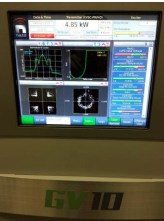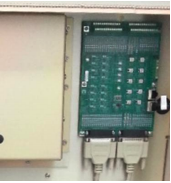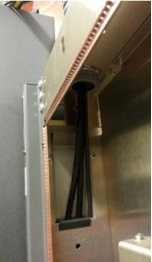Innovation Continues at Nautel: Meet The GV10
 [June 2014] The change from tubes to solid state was a big jump in technology for transmitters, significantly reducing running and maintenance costs. The challenge now was to raise the bar with innovative features. Has Nautel’s newest model met this challenge? As Alex Hartman shows, the GV series is more than a very attractive upgrade.
[June 2014] The change from tubes to solid state was a big jump in technology for transmitters, significantly reducing running and maintenance costs. The challenge now was to raise the bar with innovative features. Has Nautel’s newest model met this challenge? As Alex Hartman shows, the GV series is more than a very attractive upgrade.
Today on … err, next to the workbench is the new Nautel GV series transmitter, a GV10D (10 kW Digital) in particular. The GV series is a culmination of the previous generation NV series (including the NVlt) with some new goodies thrown into the mix.
Nautel has been leading the technology charge in radio transmission systems for over 40 years now. Over that time, it has grown from a little Canadian company to arguably the number one transmitter manufacturer in the western hemisphere, making inroads all over the world with their AM, FM, and TV transmitters – and not forgetting their original staple, the navigation beacon.
The GV series stays true to that mission. It features some quite “bleeding edge” technology for the radio transmission industry.
Less is More
The AC to RF efficiency of the NV series was around 45% (+/-5%) running at -14 dBc. The GV series will trump that by 10% or more, for quite some savings when it comes to the power and cooling bills.
 The GV series incorporates LDMOS FET technology, allowing for greater efficiency in the design.
The GV series incorporates LDMOS FET technology, allowing for greater efficiency in the design.
Paired with Nautel’s now standard “PowerBoost” software, where once a 20 kW transmitter would be required (with HD IBOC running at -14) to make a full 10 kW analog, using a new GV unit probably will require only 15 kW or even less.
To make a specific comparison at this power level, the NV-10 is capable of 7 kW analog TPO at -14 dBc HD injection; my new GV10D gets 9 kW analog TPO with a -14 dBc injection. Two kilowatts increase in analog RF is quite a bit in the same footprint.
But we will get to say more about the HD part later on. For now let us stick to the bread and butter of plain old analog FM.
Not Just Any Plain Old FM
In the analog realm, the GV series is capable of the same old things we have been seeing since the mid-60’s: composite audio input from your favorite audio processing company, metering and control, harmonic suppression well below -80 dB, etc. Okay, so it is an FM transmitter.
But here is where Nautel took it to the next level. With the introduction of the NX and NV series transmitters at NAB 2008, they started interfacing their transmitters with what they call the “AUI,” or Advanced User Interface.
 I do not want to bore folks who already know about AUI, but I do want to briefly explain some of the really neat stuff it allows you to do and see within the line of transmitters that utilize it (pretty much the entire Nautel line).
I do not want to bore folks who already know about AUI, but I do want to briefly explain some of the really neat stuff it allows you to do and see within the line of transmitters that utilize it (pretty much the entire Nautel line).
The AUI replaces all the analog metering you are used to seeing on any other rig. (You do get all that, but you also get a lot more!) It will show you a detailed look at almost anything you can imagine: like a built-in spectrum analyzer to show you if you are running within compliance, an oscilloscope function as well to look at various points within the air chain if you have issues with audio quality.
Perhaps you would like to monitor the transmitter load, the individual voltage levels on almost every discrete component in the unit, temperatures, and the various levels of efficiency. Do you need/want to see the fan RPM speed on one or all of the modules? The AUI will do that too. It will even email or text you if something goes wrong. How neat is that?!
Okay, so the AUI is pretty cool for us computer geeks. It gives us a level of control and features not seen before on any other transmitter. A few others have started incorporating similar features, but not to this level quite yet.
But then it gets even better.
Adding to NV Features
The GV series has added even more goodies to make operation better.
For example, how about a basic remote control with relays and status lights? There is no need for an outboard remote control if you so choose, the GV series incorporates that for you. You can also, you can get an “Orban Inside” card which effectively adds an Orban 5500 to the transmitter – also controllable via the AUI.
Now, I know a lot of people will say “that’s a lot of eggs in one basket, Alex!” And you would be right. If there is a catastrophic event, say a power outage, or a tornado hits the transmitter site, is the outboard gear of any use to you at that point? Probably not.
Perhaps those folks with auxiliary antennas and generators might benefit from some outboard gear, but for many stations even having a backup full power rig at the same site is a luxury these days. So, I would say that yes, it is a lot of eggs, but for 99% of users, this sort of “it’s all in there” modules will probably suit you just fine.
And, yet, there is still more.
Push Radio
Another very innovative thing that GV series (and, NV, too) incorporates is “Push Radio.”
Essentially, ENCO designed for Nautel a basic automation system built right into the transmitter as a function of the Nautel firmware. Any model capable of running AUI can utilize this feature.
This is particularly useful for any site with a need/desire for local insertion, or as a backup in case of STL failure.
Always in Control
The GV series Controller features the familiar panel from the VS series on the new controller module, utilizing the CrystalFontz LCD and six button panel we see on everything nowadays, from satellite downlinks, codecs, and transmitters.

The benefits are easy to see: if something were to go wrong with the SBC (single board computer) controlling the AUI on the front door (it is just a little ITX-style PC board after all).
This little panel should give you some peace of mind – it allows most of the controls within the GV series to be accessed here.
 The controller also has another trick to it: the “mimic panel” where all your local wiring goes as well as an Ethernet pass-through jack for remote control. It has the basic control buttons on it such as raise/lower power, change preset, RF on/off, and the ever-useful local/remote button.
The controller also has another trick to it: the “mimic panel” where all your local wiring goes as well as an Ethernet pass-through jack for remote control. It has the basic control buttons on it such as raise/lower power, change preset, RF on/off, and the ever-useful local/remote button.
The mimic board is a standard feature in the GV series (it was optional on the NVLT series), providing the convenience of having control in an easily accessed location for diagnostic purposes – it sure is easier to use a “greenie” (included!) to connect house wiring than soldering a DB25 and interfacing it with a remote control or punch block.
The controller also sports the inclusion of a pair of USB ports on the front so a USB thumb drive to be inserted for various functions, including backup audio, firmware upgrades, Orban preset saves, etc. (As with most simple USB 2.0 ports, they can only provide 500 mA on them, so do not expect them to charge your iPad while you are onsite.)
Look Ma! No IPA!
Now that we have looked into the software, let us dive into the hardware a bit more.
The GV10 has done away with any IPA stage, removing yet another point of failure. Instead, there is a direct-to-PA modulated system; the exciter generates enough horsepower (both analog and digital) to feed the four PA stages directly,
The GV exciter is capable of taking not just composite baseband audio, it can take analog audio, AES digital audio, IP audio from say a Shoutcast/Icecast stream, as well as composite over AES.
This is the new MPX over AES spec pioneered by Nautel and Omnia, keeping the entire air chain digital through and through. You have now several options of audio delivery for pretty much any design.
The GV series can be outfitted with two exciters for a failover situation for those insecure types out there.
Redesigned Power Supply
The power supplies got a bit of an upgrade as well from the NV series.
These are GE made, 50 Volt, 2750 Watt per unit power supplies. My GV10D came with 10, all identical.

There are ten power supplies in the GV10D
The outer four on either side are for the PA decks and the central pair are for low voltage components, such as the controller, exciter and other stuff. These supplies are hot-swappable and the transmitter folds back when one is pulled or failed.
Interestingly, Nautel has made a “UPS interface” for this transmitter. However, it is not for the PA power supplies; it is just for the low voltage to handle brownouts and bumps in the power, thus negating the reboot time of the exciter and controller. It allows “inlet” ports from a standard off-the-shelf UPS (like what you would find on an RV for a generator). It is little things like this that set Nautel apart from their competitors.
Putting Your Ducts in a Row
Taking the back panel off is done with about a dozen quarter-turn plastic clasps.
There is really not a whole lot going on back here. There is an interface board for all the PA modules, a traffic director that controls the bias of the PA for dynamic HD IBOC injection, and the wiring harnesses.
 One really nice new thing that Nautel has done with the GV series is that they added “wiring ducts.” What a simple, yet very effective idea.
One really nice new thing that Nautel has done with the GV series is that they added “wiring ducts.” What a simple, yet very effective idea.
The idea for this was suggested by several Nautel users and lo and behold, Nautel was listening.
There are two of these ducts, one on either side of the transmitter in the back. One is for your AC power wiring, the other is for all of your control, audio, and interface wiring.
The AC wiring duct goes all the way down past the main rear cavity into the power supply cabinet and then pops out right next to the AC mains wiring lugs. I really like this. It keeps everything safe, nobody accidentally climbing around the AC line voltages with random screwdrivers, keeping everything protected.
The other duct goes from the top inlet to the bottom of the main PA section down by where the controller and exciter live. In my particular installation, I had to route about eight cables into it for various items (mod monitor, composite, AES audio, 10 MHz GPS sync, control and status wiring, two Ethernet cables).
It does get pretty tight, you will want to terminate the cables once they have been installed, getting XLR or BNC connectors to bend can be a tricky business.
The GV series also comes pre-wired for any options you may purchase in the future, such as the extra exciter or UPS option. All you have to 5 do is buy the items from Nautel and drop them in, all the cables are there waiting for you.

The ancillary kit that comes with the transmitter also contains several ferrite rings for audio lines, transmission lines and other items you may wish to protect.
Light on Its Feet
One thing you will notice about the GV series (and even the NV/NVlt series) is how amazingly light these transmitters are.
Fully crated my GV10D was just shy of 700 pounds, uncrated and on the ground it is just a tad over 415 pounds. A couple guys could walk this thing around pretty easily compared to the big iron-wielding monsters from just a few years ago.
With that in mind, be sure to be careful not to torque the box too much walking it around to position it.
RF Section Efficiency
Turning now to the HD side of things, the GV series is a little bit of old trick, new trick when it comes to IBOC.
The older NV series power curve was different depending on where in the band you were – it would be a little more efficient on the upper part of the band and less so on the lower. In contrast the GV is flat across the board as far as power curves are concerned. No matter the dial position, the LDMOS FET that Nautel has chosen has the same efficiency – 88.1 or 107.9, you will see the power savings.
Speaking of efficiency, as I mentioned, the AC to RF numbers are impressive, but the DC to RF numbers are equally as impressive – very little power is wasted.
My GV10D running at half power with -14 dBc injection is getting a 74.8% efficiency. When it runs into a dummy load at the full 9 kW output with -14 dBc, that number jumped up to 89% There is not much wasted juice there.
At a -10 dBc injection the best you can run is 6.5 kW power output. That brought the efficiency number down around 79%. This is in part from the LDMOS FETs employed, along with the PowerBoost and HD Optimizer doing their magic via software.
In fact, putting your hand over the exhaust you might be forgiven for wondering if the transmitter is on at all.
Another thing to keep in mind is, unlike previous generations, the rated power on the GV series is “worst case,” meaning MP3 HD mode. So you do not have to worry about calculating in the extra overhead for MP3 mode, Nautel has taken that guesswork out of it for you.
The GV series is also capable of asynchronous sidebands, with a push of a few buttons on the 6 AUI in the Presets menu, you can have a -10 lower and -14 upper.
HD Optimizer
Another new trick the GV series has is the “HD Optimizer.”
The optimizer software function is quite innovative: using a set of “rules” the transmitter follows the rules to maintain an absolute maximum IBOC output based on your specifications, not Nautel’s.

For example, iIf you want to maintain a -1 dB clearance on the IBOC mask, just tell it to do that, and it will adjust the PA voltages appropriately.
Again, there is no need for constant tweaking to make sure your plant is always running at its top efficiency. Nautel has taken the guess work out of it at every step of the way.
Top Notch Support
At the end of the day, it is just a transmitter, but it is a transmitter with a boatload of features replacing several other items within your air chain and tool chest.
The touch screen on the front gives you an at-aglance overview of the performance of the box. Color-coded buttons show alarms, warnings, and other status situations.
Nautel includes their 4-year warranty. With an IP-enabled site and utilizing Nautel “Phone Home,” the factory will be informed of impending problems and failures – most likely even before you are aware of them.
Deeper Diagnostics
The GV Series is a “software defined transmitter” series. A lot of functionality potential exists inside and I am sure we are not done seeing some of the stuff Nautel has planned for this very versatile platform.
Hence, if a software issue pops up somewhere, Nautel’s Remote Service support system goes into action. Once implemented, it automatically, pokes an outbound hole through the firewall and allows the support team into your transmitter for further diagnostics. There is no running around with any of the third party “remote desktop” suites – Nautel has their own set of keys.
The Remote Service is a good example of how Nautel is always listening to their users’ advice and input as well. If the feature makes sense, they will probably implement it.
As you can readily see, the GV series has been born of a lot of those suggestions as seen here.
Top Choice
Would I recommend a Nautel transmitter?
Absolutely. They are not always the cheapest guy on the block, but the extras you get like Phone Home, the Orban Inside options, not to mention the customer service puts them on a pretty high shelf.
I have gone from owning a single VS1 to having two VS300LP’s and now the GV10 in my fleet. With the transmitter performance, features, and customer service I have gotten, I would not hesitate to recommend them.
With the GV10D, Nautel is continuing its tradition of innovation – something we hope to see for some time to come. And, as is always mentioned, they have never discontinued supporting a product in over 40 years. Find another company who will say that in public, I dare you.
– – –
Alex Hartman is a contract engineer, based in St. Cloud, for a number of stations in Minnesota, including KVSC-FM. Contact Alex at: goober@goobe.net
